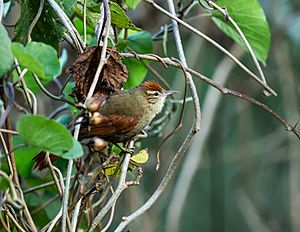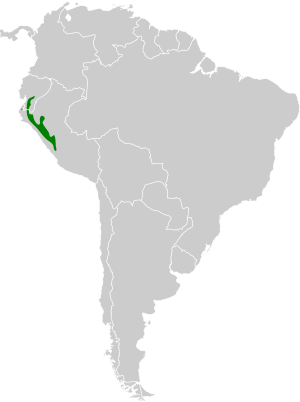Line-cheeked spinetail facts for kids
Quick facts for kids Line-cheeked spinetail |
|
|---|---|
 |
|
| Line-cheeked spinetail, Cranioleuca antisiensis | |
| Conservation status | |
| Scientific classification | |
| Genus: |
Cranioleuca
|
| Species: |
antisiensis
|
 |
|
| Synonyms | |
|
Synallaxis antisiensis (protonym) |
|
The line-cheeked spinetail (Cranioleuca antisiensis) is a type of bird that lives in trees. It belongs to the ovenbird family, called Furnariidae. You can often find this bird in the Andes mountains in Ecuador and Peru.
These birds like to live in wet, tropical mountain forests, woodlands, and bushy areas. They are special because of where they live, how they act, and the white stripe above their eyes, called a supercilium. Scientists have identified two main types, or subspecies, of line-cheeked spinetails. These types show small changes in their looks and feathers from one area to another.
Contents
What it Looks Like
The line-cheeked spinetail is a medium-sized bird. It weighs about 15–18 grams and is about 14.5 centimeters long. Like other spinetails, it has a long tail that gets narrower at the end. Its beak is also quite long and curves down a little.
This bird has a reddish-brown top of its head and a clear white stripe above its eye. Its throat is pale, and it has some streaks on the feathers covering its ears. Its back is brown to olive-grey, and its chest and belly are greyish-brown. The tail and wings are a reddish-brown color.
Where it Lives
The line-cheeked spinetail lives along the western side of the Andes mountains. You can find it in southwest Ecuador and western Peru. These birds live at different heights, from about 800 meters up to 3000 meters above sea level. The highest point they live at is usually where the trees stop growing on the mountainside.
They prefer places with dense, evergreen plants, like mountain scrub forests and forest edges. They don't usually live in very dry or deciduous (trees that lose their leaves) areas.
How it Behaves
Line-cheeked spinetails are active during the day. They sing most loudly at dawn (sunrise) and dusk (sunset). This helps them protect their nesting areas. You can often see a single bird singing from branches high up in trees.
Their calls sound like chirps and scolding noises. Their song is a series of loud, high-pitched sounds that usually end with a trill (a quick vibrating sound) before fading away. Both young and adult birds react strongly to recordings of their songs. This suggests they can be aggressive towards other birds of their kind.
These birds usually defend small areas as a family group. These groups often have 2–4 adult birds and 1–2 young birds. Sometimes, you might also see them mixed in with other types of birds.
Reproduction and Life Cycle
Scientists don't know much about how line-cheeked spinetails find a mate. However, it's thought that they stay with one partner. They usually build their nests around February and March and lay two eggs.
Their nests are often large and oval-shaped. They build them at the ends of tree branches. One nest found in Ecuador was shaped like a dome and built under a palm leaf. It was made from moss, vines, and hairy seeds on the outside. The inside was lined with palm fibers, leaves, and plant roots. We don't know much about how long the parents sit on the eggs or how they care for their young. However, young birds that have just learned to fly are seen by August.
What it Eats
Like other birds in the ovenbird family, line-cheeked spinetails eat insects. We don't know their exact diet yet. They mostly find their food by picking insects off plants near the ground and in bushes. Sometimes, they also go higher up into the tree canopy to look for food.
Conservation Status
The line-cheeked spinetail is listed as "Least Concern" by the IUCN Red List. This means that its population is stable and not currently at risk. It is a common bird throughout the areas where it lives.
However, because these birds live in trees, they can be affected by deforestation (when forests are cut down). Luckily, they can handle some human activity and do well in areas where new plants are growing after a disturbance.


